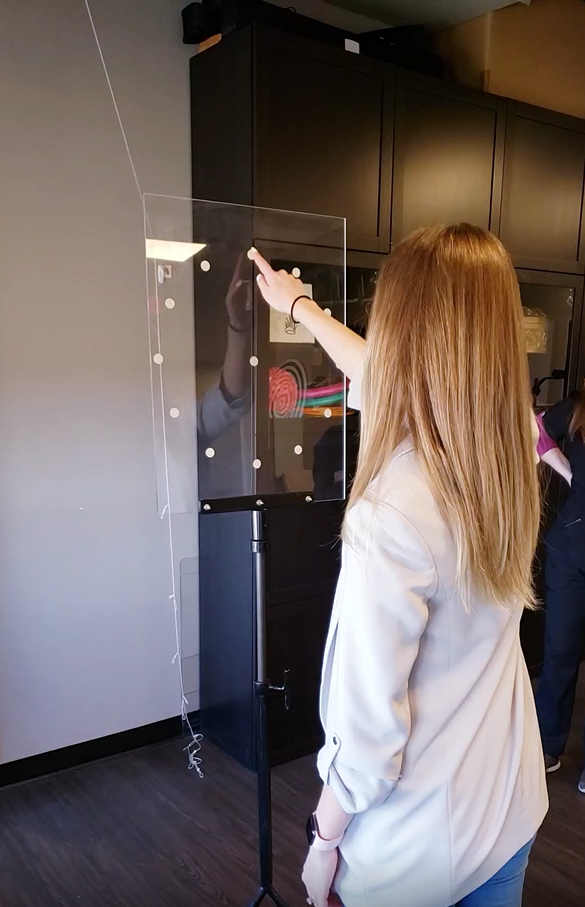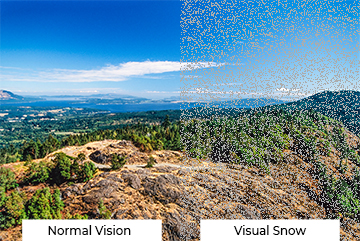Visual Snow Syndrome
Is a neurological condition that is characterized by persistent visual abnormalities. These abnormalities can range from mild to severe, with the main abnormality being visual snow, often described as constant flashing dots or static throughout the visual field. Visual Snow Syndrome impacts an individual’s vision, hearing, cognition, sensory processing and quality of life. Visual Snow Syndrome can affect all ages and backgrounds. The exact cause of Visual Snow Syndrome is still unknown but research is still on going. It has been suggested that Visual Snow Syndrome is related to changes in the visual processing centers of the brain and alterations in the neural signals between the eyes and the brain, it has also been linked to hyperactivity in the visual cortex of the brain. Studies on the effectiveness of Neuro-Optometric Vision Rehabilitation Therapy for those with visual snow syndrome have showed an improvement in Quality of Life through this treatment.

As previously stated, the manifestations of Visual Snow Syndrome differ considerably among individuals, but frequently comprise some or all of the following:
Visual Symptoms
- Visual snow (dynamic snow-like dots across the entire visual field)
- Palinopsia (continuing to see an image after the stimulus has been removed)
- Photopsia (flashes of light or small floating objects)
- Enhanced entoptic phenomena (excessive floaters and rings of light shooting across the entire visual field, more noticeable when looking at bright surfaces such as the blue sky)
- Photophobia (sensitivity or intolerance to light)
- Nyctalopia (impaired night vision)
- Diplopia (double vision)
- Other visual phenomena, such as starbursts and halos
Non-Visual Symptoms
- Tinnitus (ringing or buzzing noise in the ears)
- Anxiety
- Depression
- Depersonalization (feeling detached from yourself)
- Frequent migraines
- Brain fog and confusion
- Dizziness
- Nausea
- Paresthesia (tingling “pins-and-needles” sensations, commonly in the arms, hands, legs and feet)
- Insomnia and other sleep-related issues

A Neuro-Optometric Vision Rehabilitation assessment for Visual Snow Syndrome involves in-office examinations to evaluate the individual’s visual system and to identify any underlying issues that may be contributing to their symptoms.
Neuro-Optometric Vision Rehabilitation is a specialized therapy that uses novel experiences and activities to improve visual function and the quality of life for those with neuro-vision conditions. A variety of active therapies are used to reeducate the visual system (eyes, brain and body). These activities are tailored to the individual, and follow their specific needs.
Along with active therapy, those with Visual Snow have found improvements in their symptoms with various lenses, prisms and tints that their Neuro-Rehabilitative Optometrist can prescribe.
Hallucinogen Persisting Perception Disorder (HPPD) is a condition in which an individual, while sober, re-experiences the perceptual disturbances that occurred while they were under the influence of a hallucinogenic substance. A common manifestation of Hallucinogen Persisting Perception Disorder (HPPD) is visual snow. HPPD is linked to previous exposure to psychedelic drugs, and can be aggravated or triggered by substance use. Visual Snow Syndrome, on the other hand, can arise spontaneously without any substance use history.
At this time there are no studies on HPPD and Neuro-Optometric Vision Rehabilitation, however assessment and treatment of any underlying visual conditions may help to reduce some visual symptoms and improve quality of life.
References
1 - Visual Snow Initiative : https://www.visualsnowinitiative.org/
2 - Dr Tsang, Dr Shidlofsky The Efficacy of Neuro-Optometric Visual Rehabilitation Therapy in patient with Visual Snow Suntrome. https://pubmed.ncbi.nlm.nih.gov/36545398/